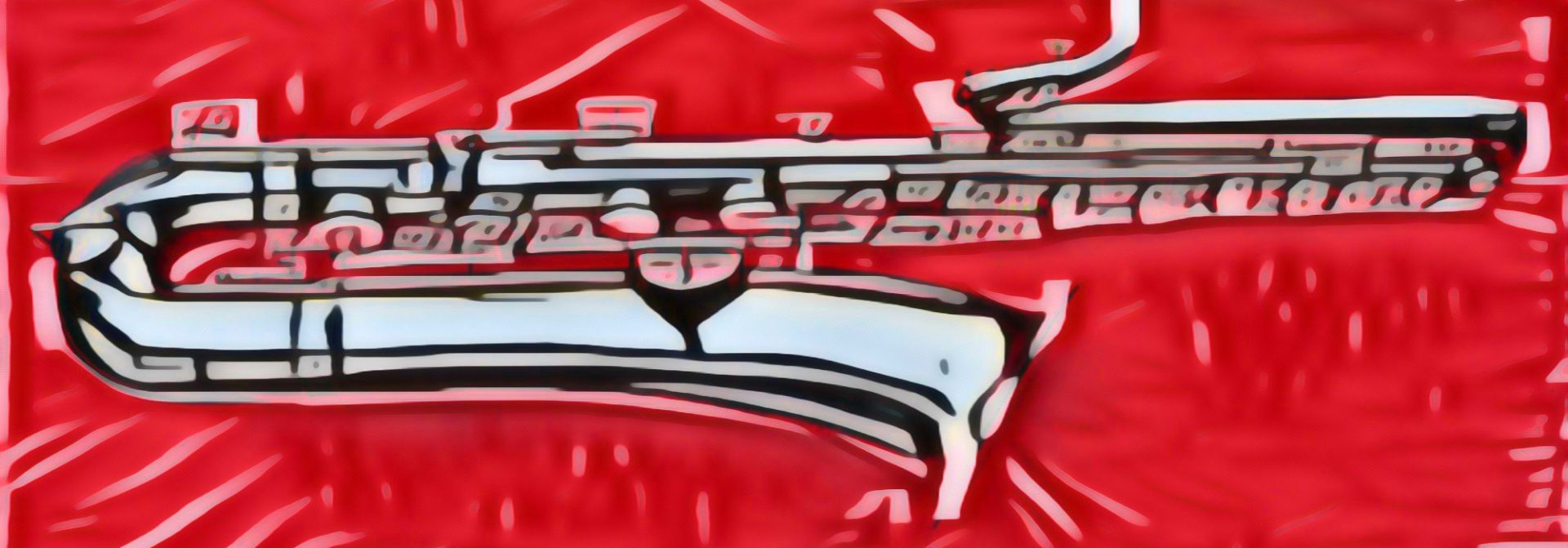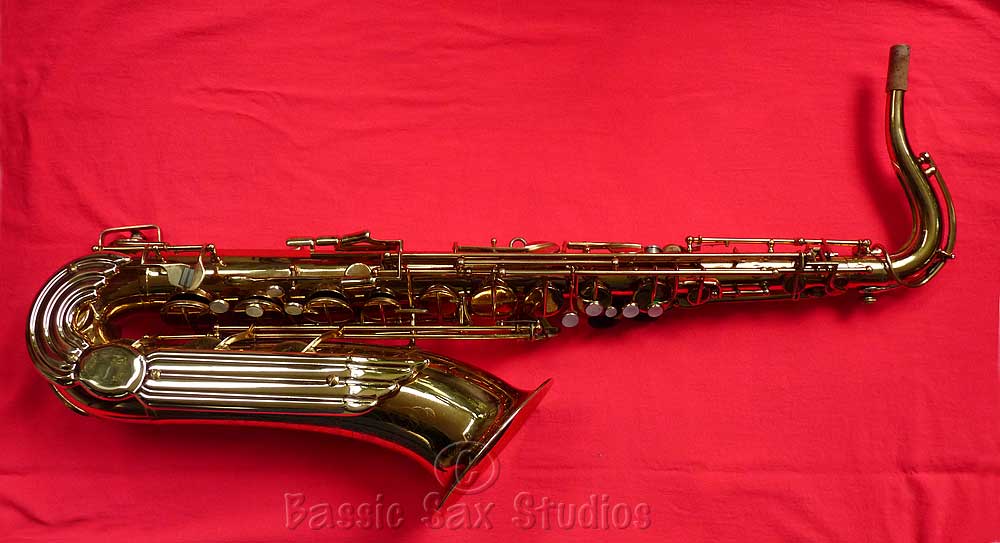A thread on SOTW got me thinking about a term that is bandied about so much, that it has basically become meaningless. The term vintage saxophone has been used to describe everything from 100+ year-old horns—which would really be considered antiques in the truest sense of the word—to modern horns with a faux vintage finish.
For example, this is my Evette & Schaeffer HP baritone from 1886. It is not a vintage sax. This is, in fact, an antique.
Not a vintage saxophone, but rather an antique

This SX 90 R by Keilwerth is not a vintage sax either. It’s just one of the countless modern horns that manufacturers of both expensive and cheap horns are currently producing with faux vintage finishes, in an effort to try to cash in on the current interest in vintage saxophones.
Not even close to being a vintage saxophone

This is the above tenor’s bell engraving. Oh, just as an aside, if it says “vintage” on the engraving, it’s not a vintage saxophone… yet. 😉

Years ago, saxophone historian Pete Hales provided a good working definition of vintage saxophone:
There is a difference between “vintage” and “old”. To me, when you say that you have a “vintage instrument” it should ….
a. No longer be produced, anywhere.
b. Have been considered a professional make and model when it was made.
c. Have value as a professional make and model, today, as a playable instrument or have value as a collectible make and model (for instance, a high-pitch Conn New Wonder alto saxophone in Virtuoso Deluxe finish — a very expensive, elaborate, gold plated, heavily engraved finish with additional pearl key touches — is still “vintage”, even though it has virtually no playability value).
d. Have maintained its original value, adjusted for inflation, or increased in value.
“Vintage”, to me, should have the connotation of a fine wine: “It’s an excellent vintage.”
Or, using an analogy from the automobile world, a 1934 Cord is vintage. A 1972 Ford Pinto is old.
In the saxophone world, think of it this way: A Martin Master is vintage, a Bundy II is old. Or how about this one: a Julius Keilwerth Toneking is vintage, while a Super Grange is old.
A true vintage saxophone

There is one part of Pete’s definition that I disagree with. In section b. Pete writes that the horn should have been considered a professional make and model when it was made. I don’t necessarily think this always needs to be the case.
Case in point: the Pan American horns that were built by Conn. These horns were Conn’s second-line horns, but I would argue they are still vintage saxophones.
Pan American saxophones ranged a great deal in features and styles over the years, and some were pretty striped down versions. However, for the most part, many still meet the rest of Pete’s criteria for vintage saxophones:
- They’re no longer being produced anywhere.
- They still have value today as a playable instrument.
- They have maintained their original value, adjusted for inflation, or in some cases even increased in value. (Think of Pan American bass saxophones.)

Besides Conn’s Pan American, there are quite a few other non-professional model saxophones that could be considered vintage, if you take away the professional requirement in Pete’s definition.
For example, The New King by Julius Keilwerth was almost the same as the Toneking. The body tubes and necks were the same, and the key layout was the same. The only difference was that the Toneking was keyed to high F#, while The New King was keyed to high F. Yet JK considered The New King their intermediate level horn, while the Toneking was their pro horn.
Using Pete’s definition of vintage, The New King would not be considered a vintage horn, since it was not “considered a professional make and model when it was made”. In my mind this simply doesn’t make sense. I believe we need to have some flexibility in this area.
That said, we shouldn’t open the flood gates and allow for every POS saxophone ever built in the 20th century to suddenly be called vintage either. There has to be some common sense applied. This common sense has to be used by sellers, but more importantly, by potential buyers of vintage saxophones.
If a buyer doesn’t use their common sense, and some vintage saxophone-buying savvy, they’ll end up spending way too much money on a junker horn being sold as vintage.
If you’ve got any ideas on how to improve on Pete’s definition of vintage, I’m all ears. Leave a comment and let’s discuss.
Notice that I’ve purposely left out discussions of pre-1980, or other age-specific criteria. I know that 1980 is currently the common age cut-off for vintage versus modern horns. IIRC, this may have come from eBay.
I have also left out a discussion of features. Among other things, this takes away those endless and fruitless debates about whether or not Mark VIs are truly vintage saxophones. Let’s just say that they are, and move on. 




Quoth Pete:
“Vintage”, to me, should have the connotation of a fine wine: “It’s an excellent vintage.”
This, for me, gets to the heart and soul of it. A “vintage” horn is a best of breed sort of beast. It is not merely an antique, nor an instrument that was marketed to an elite customer, but rather an instrument that has become to be recognized as exceptionally good at what it does.
Maybe we can expand “top-line” to include “instruments chosen by working musicians of the day”? Of course this means more than one or two cases — I doubt that my Jupiter 767 is ever going to be “vintage” despite the fact that I’ve used it professionally for years. It’s not that it’s a bad horn either, at least MY two examples aren’t. A lot of them were though, and I had to wade through a pile of crap horns to cherry-pick the good one from the lot. I got lucky with the second one, I bought it from a SOTW denizen who said it was one of the better examples HE had seen. (It’s still not as good as the one I picked, but it has potential.)
Similarly, there’s probably someone out there with a really nice-sounding and comfortable Mexi-Conn. That wouldn’t make them vintage either.
I don’t know where this would leave my Dolnet bari. It was the nicest one Dolnet made, but it was seriously behind the times for 1963-ish when it was made. I know there were some serious pros playing Dolnet tenors, but I haven’t heard much about them playing the baris. So just because something was marketed as a top-line horn doesn’t really make it vintage either. It had to have had a reasonably good reputation at the time it was sold, not just marketed as “professional”.
Also, it was (and remains) common practice to use a backup horn for situations where you don’t want to expose the expensive horn to the risk of damage. Yet a pro is unlikely to settle for a horn that is seriously deficient, and quite often the backup is substantially similar to what they normally play for ease of switching. I know one studio player who plays a Yamaha Custom Z as his primary horn, but has a Yamaha-made Vito he’ll pull out for anything outdoors. (I know because I sold it to him — it was intended for his niece but he liked it too much to part with it.) Where on the scale does an acceptable backup horn cease to be eligible for the “vintage” designation?
Interesting point on the Dolnet bari. It’s a good example of your point.
I don’t know of anyone else who has owned a Dolnet bari, or even has played one, so I can’t say if yours was especially bad, or if they were all bad. It is a bit like the Holton horns. Are they, or are they not vintage saxophones? In my mind, anything but the Rudy Wiedoeft models are not vintage, and even the Rudy Wiedoeft horns are suspect. That said, I suspect that SOTW’s Holton brigade would like to tar and feather me for comments like this. 😉
With regards to backups, I figure they are just like any other horn, and should be evaluated as a saxophone, not as a backup sax. But you raise the good example of the Yamaha-stencilled Vito.
Stencil horns can, in my mind anyway, be vintage, if they meet the criteria set out by the definition. Case in point, JK’s Series III Tonekings were the most stencilled of all the company’s horns. And unlike American stencil saxophones, the Toneking stencils had all the features of their brand-name cousins. (Which was the case in European horns in general.)
My problems with the Dolnet bari seem to be design flaws, not specific to mine alone. Granted, mine has probably taken knocks that give it quirks of its own, and it’s possible that its tendency to go sharp on the bell notes with anything but super-wedged mouthpieces is due to manufacturing errors, but it seems unlikely to me. If the parts were so wrong as to seriously affect tuning, they shouldn’t have fit in the first place. It ALSO went sharp in the palm keys, but this is not particularly difficult to correct (and I have).
Most of my problem with the horn is its keywork. It’s just clunky and “soft”, for lack of a better word. The long rods necessary for a large instrument are inherently prone to this, so it probably didn’t manifest as much in the tenors and probably not at all with the altos. But on a bari, there’s plenty of room for them to whip about and get torqued. The first can be solved by retaining posts that go all the way around the rod rather than just cupping it from one side — but they didn’t do this. The second requires a harder alloy (or special treatments) and/or thicker rods, and they didn’t do this either. More metal means more mass (inertia) which also means slower keywork or stiffer springs as well as a heavier instrument. Better metal and heat treatments usually mean more cost, but avoid a weight penalty. Given that this came AFTER WW2, I’m pretty sure they knew how to suitably make copper alloys and perform annealing and the like. It just probably cost too much. Unfortunately, it really shows on the long rods and keys with multiple linkages, like the pinky cluster and the low A. It also lacks an articulated low C#. I’ve seen articulated low C# mechanisms retrofitted onto horns with outside axles, and had even come up with a design of my own which turned out to look a great deal like the way it’s actually done in practice. The people who designed this instrument COULD HAVE DONE this, and there are contemporary instruments which did. All of these problems are magnified by the fact that it IS a low A horn — that’s just one more long bell key to have to maneuver around, both mechanically and musically.
It’s pretty. It has a nice and fairly “big” sound. And of course, it has a low A. It was the best model bari Dolnet ever made. That still doesn’t make it worthy of the designation “professional”, though they tried to pass it off as such. I think in 1963, just having a low A was unusual enough to slap the “professional” designation on it. Nowadays of course, there are plenty of intermediate-level baris sporting a low A and a high F# (would have been nice, not likely to have one retrofitted at this point).